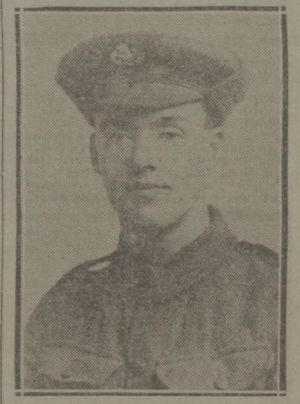George Sanders (VC) facts for kids
Quick facts for kids
George Sanders
|
|
|---|---|

Sanders pictured in the Leeds Mercury on the announcement of his Victoria Cross award
|
|
| Born | 8 July 1894 Leeds, West Yorkshire, England |
| Died | 4 April 1950 (aged 55) Leeds, West Yorkshire, England |
| Allegiance | |
| Service/ |
|
| Years of service | 1914-1919 |
| Rank | Captain |
| Unit | West Yorkshire Regiment |
| Battles/wars | First World War |
| Awards | |
George Sanders (born July 8, 1894, died April 4, 1950) was a brave English soldier. He received the Victoria Cross (VC) and the Military Cross (MC). The Victoria Cross is the highest award for bravery in battle for British and Commonwealth soldiers.
Contents
Early Life
George Sanders grew up in Leeds, England. His parents were Thomas and Amy Sanders. He went to Little Holbeck School. After school, he became an apprentice fitter at Airedale Foundry. This means he learned how to build and fix machines.
Military Service in World War I
George joined the army on November 9, 1914. He became a private, then a corporal. He served in the 1/7th (Leeds Rifles) Battalion. This was part of the West Yorkshire Regiment. His unit went to France in April 1915. In 1916, they fought in the Battle of the Somme.
Bravery at the Somme: VC Action
On July 1, 1916, near Thiepval, France, Corporal Sanders showed amazing bravery. His group of 30 men became separated from their main unit. They were deep inside enemy trenches. For 36 hours, Sanders and his men fought off German attacks. He organized their defenses and told his men they had to hold their ground.
During this time, they had no food or water. They even gave their water to wounded soldiers. When help finally arrived, Sanders led the 19 survivors back to their own lines. His actions earned him the Victoria Cross. This award was announced on September 9, 1916.
Later Service and MC Award
After receiving his Victoria Cross, George Sanders returned to the front. In July 1917, he became an officer. He was made a temporary Second Lieutenant. By December 1917, he was an acting Captain.
In April 1918, the German army launched a big attack. Captain Sanders was with the 1/6th Battalion. They were fighting at Mount Kemmel. Sanders showed great courage during the heavy fighting. He even stood on top of a "pill-box" (a small concrete bunker) and fired his revolver at the enemy. His bravery inspired his men. For this, he received the Military Cross.
Prisoner of War
On April 25, 1918, Captain Sanders was captured by the Germans. He was wounded in his right arm and leg. He was held at the Limburg POW camp. In July, he managed to send a letter to his father. He was sent back to England on December 26, 1918. He left the army in March 1919.
Later Life
After the war, George Sanders attended several special events. In June 1920, he went to a victory party. In November 1929, he attended a reunion dinner for Victoria Cross holders. Both events were at Buckingham Palace.
In 1921, he unveiled the Leeds Rifles War Memorial. This memorial is at Leeds Minster. George Sanders died in Leeds on April 4, 1950. He was 55 years old. His funeral was held at Cottingley Crematorium.
Medals
George Sanders' medals, including his Victoria Cross and Military Cross, were sold in 2017. They were bought by Lord Ashcroft. These important medals will be displayed at the Imperial War Museum.

